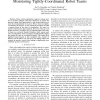Free Online Productivity Tools
i2Speak
i2Symbol
i2OCR
iTex2Img
iWeb2Print
iWeb2Shot
i2Type
iPdf2Split
iPdf2Merge
i2Bopomofo
i2Arabic
i2Style
i2Image
i2PDF
iLatex2Rtf
Sci2ools
ICRA
2006
IEEE
2006
IEEE
Experiments with an Ecological Interface for Monitoring Tightly-coordinated Robot Teams
Abstract— Many robotics applications require a human operator to monitor multiple robots that collaborate to achieve the operator’s goals. Most approaches to such monitoring focus on each robot independently of its peers. When robots are tightlycoordinated, the operator is thus cognitively burdened to build a mental picture of the state of coordination. We report on extensive experiments (approximately 100 hours) with up to 25 human operators, working in two coordinated multi-robot tasks. In these, we contrasted standard displays, which assume each robot is independent, with an ecological socially-attentive display that makes the state of coordination explicit. The results show significant improvements in task completion time, number of failures, and the failure rate. Moreover, the display reduces the variance in operator control, thus leading to significantly more consistent operator performance.
Human Operators | ICRA 2006 | Operator’s Goals | Robot | Robotics |
| Added | 11 Jun 2010 |
| Updated | 11 Jun 2010 |
| Type | Conference |
| Year | 2006 |
| Where | ICRA |
| Authors | Gal A. Kaminka, Yehuda Elmaliach |
Comments (0)

